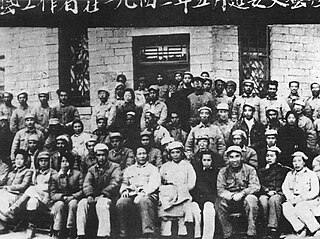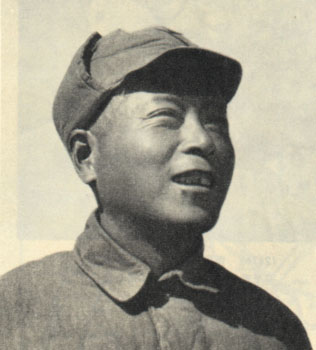Agrarianism is a social and political philosophy that promotes subsistence agriculture, family farming, widespread property ownership, and political decentralization. Adherents of agrarianism tend to value traditional bonds of local community over urban modernity. Agrarian political parties sometimes aim to support the rights and sustainability of small farmers and poor peasants against the wealthy in society.

Deng Xiaoping was a Chinese revolutionary and statesman who served as the paramount leader of the People's Republic of China (PRC) from December 1978 to November 1989. After Chinese Communist Party chairman Mao Zedong's death in 1976, Deng rose to power and led China through its process of Reform and Opening Up and the development of the country's socialist market economy. Deng developed a reputation as the "Architect of Modern China" and his ideological contributions to socialism with Chinese characteristics are described as Deng Xiaoping Theory.

Mao Zedong was a Chinese politician, Marxist theorist, military strategist, poet, and revolutionary who was the founder of the People's Republic of China (PRC). He led the country from its establishment in 1949 until his death in 1976, while also serving as the chairman of the Chinese Communist Party during that time. His theories, military strategies and policies are known as Maoism.

Maoism, also known as Mao Zedong Thought, is a variety of Marxism–Leninism that Mao Zedong developed while trying to realize a socialist revolution in the agricultural, pre-industrial society of the Republic of China and later the People's Republic of China. A difference between Maoism and traditional Marxism–Leninism is that a united front of progressive forces in class society would lead the revolutionary vanguard in pre-industrial societies rather than communist revolutionaries alone. This theory, in which revolutionary praxis is primary and ideological orthodoxy is secondary, represents urban Marxism–Leninism adapted to pre-industrial China. Later theoreticians expanded on the idea that Mao had adapted Marxism–Leninism to Chinese conditions, arguing that he had in fact updated it fundamentally and that Maoism could be applied universally throughout the world. This ideology is often referred to as Marxism–Leninism–Maoism to distinguish it from the original ideas of Mao.

The people's commune was the highest of three administrative levels in rural areas of the People's Republic of China during the period from 1958 to 1983, until they were replaced by townships. Communes, the largest collective units, were divided in turn into production brigades and production teams. The communes had governmental, political, and economic functions during the Cultural Revolution. The people's commune was commonly known for collectivizing living and working practices, especially during the Great Leap Forward. The scale of the commune and its ability to extract income from the rural population enabled commune administrations to invest in large-scale mechanization, infrastructure, and industrial projects. The communes did not, however, meet many of their long-term goals, such as facilitating the construction of socialism in the rural areas, liberating women from housework, and creating sustainable agriculture practices in the countryside. They ranged in number from 50,000 to 90,000.

On the Ten Major Relationships is a speech by Mao Zedong which outlines how the People's Republic of China would construct socialism different from the model of development undertaken by the Soviet Union. It was delivered by Mao during an enlarged session of a Politburo meeting of the Chinese Communist Party on April 25, 1956 and further elaborated in the 7th Supreme State Conference on May 2 the same year.

Gao Gang was a Chinese Communist Party (CCP) leader during the Chinese Civil War and the early years of the People's Republic of China (PRC) before he became the victim of the first major purge within the party since before 1949. The events surrounding Gao's purge, the so-called "Gao Gang Affair", are still the subject of debate: a limited amount of research has been done on the topic, partly because of the relatively small amount of information available.

Zhang Wentian was a Chinese politician who was a high-ranking leader of the Chinese Communist Party (CCP).

The Yan'an Rectification Movement was a political mass movement led by the Chinese Communist Party (CCP) from 1942 to 1945. The movement took place in the Yan'an Soviet, a revolutionary base area centered on the remote city of Yan'an. Although it was during the Second Sino-Japanese War, the CCP was experiencing a time of relative peace when they could focus on internal affairs.
The economic history of China describes the changes and developments in China's economy from the founding of the People's Republic of China (PRC) in 1949 to the present day. The speed of China's transformation in this period from one of the poorest countries to one of the world's largest economies is unmatched in history.
The mass line is the political, organizational and leadership method developed by Mao Zedong and the Chinese Communist Party (CCP) during the Chinese Communist Revolution. It refers to formulating policy based on theory, implementing it based on people's real world conditions, revising theory and policy based on actual practice, and using that revised theory as the guide to future practice. In Maoist terms, it is summarized by the phrase, "To the masses - from the masses - to the masses".
The sent-down, rusticated, or "educated" youth, also known as the zhiqing, were the young people who—beginning in the 1950s until the end of the Cultural Revolution, willingly or under coercion—left the urban districts of the People's Republic of China to live and work in rural areas as part of the "Up to the Mountains and Down to the Countryside Movement".

The Yan'an Forum on Literature and Art was a May 1942 forum held in the Yan'an Soviet and a significant event in the Yan'an Rectification Movement. It is most notable for the speeches given by Mao Zedong, later edited and published as Talks at the Yan'an Forum on Literature and Art which dealt with the role of literature and art in the country. The two main points were that (1) all art should reflect the life of the working class and consider them as an audience, and (2) that art should serve politics, and specifically the advancement of socialism. The excesses of the latter point during the Cultural Revolution led to current Chinese Communist Party policy rejecting that point, but retaining Mao's encouragement of peasant-focused art and literature.

Collective farming and communal farming are various types of "agricultural production in which multiple farmers run their holdings as a joint enterprise". There are two broad types of communal farms: agricultural cooperatives, in which member-owners jointly engage in farming activities as a collective; and state farms, which are owned and directly run by a centralized government. The process by which farmland is aggregated is called collectivization. In some countries, there have been both state-run and cooperative-run variants. For example, the Soviet Union had both kolkhozy and sovkhozy.
Agrarian socialism is a political ideology that promotes social ownership of agrarian and agricultural production as opposed to private ownership. Agrarian socialism involves equally distributing agricultural land among collectivized peasant villages. Many agrarian socialist movements have tended to be rural, locally focused, and traditional. Governments and political parties seeking agrarian socialist policies have existed throughout the world, in regions including Europe, Asia, North America, Latin America, and Africa.

Deng Zihui was a Chinese communist revolutionary and one of the most influential leaders of the People's Republic of China during the 1940s and 1950s. He was one of the major military leaders of China during the Chinese Civil War along with Mao Zedong, Zhou Enlai, Peng Dehuai and Lin Biao.

Li Jingquan was a Chinese politician and the first Party Committee Secretary (governor) of Sichuan following the establishment of the People's Republic of China in 1949. He supported many of Mao Zedong's policies including the Great Leap Forward.

The Land Reform Movement, also known by the Chinese abbreviation Tǔgǎi (土改), was a mass movement led by the Chinese Communist Party (CCP) leader Mao Zedong during the late phase of the Chinese Civil War after the Second Sino-Japanese War ended in 1945 and in the early People's Republic of China, which achieved land redistribution to the peasantry. Landlords – whose status was theoretically defined through the percentage of income derived from exploitation as opposed to labor – had their land confiscated and they were subjected to mass killing by the CCP and former tenants, with the estimated death toll ranging from hundreds of thousands to millions. The campaign resulted in hundreds of millions of peasants receiving a plot of land for the first time.
The 1st Five-Year Plan was the first five-year plan adopted by the People's Republic of China after its establishment in 1949. It lasted from 1953 until 1957.

The Beidaihe Conference of 1958 was an enlarged meeting held by the Politburo of the Chinese Communist Party Central Committee from August 17 to 30 1958. It also involved a conference of provincial industrial secretaries and other relevant local leaders from the 25th to the 31st.












